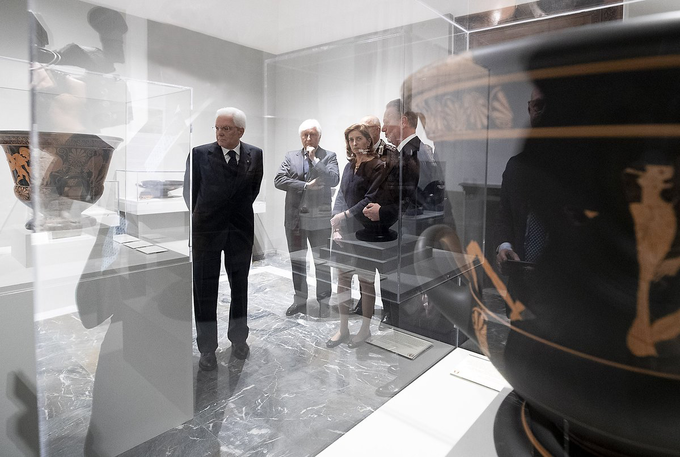


Founded in 1969 by General Arnaldo Ferrara, the Comando Carabinieri Tutela Patrimonio or TPC [2] was the first specialist force dedicated to combating art and antiquities crimes in the world. To this day, it remains the largest and most respected, having recuperated almost 2 million artworks in total.
An exhibition titled “The Art of Saving Art, Fragments of Italian History” [3] is on view in Rome’s Quirinal Palace, the seat of the President of the Republic, to celebrate the Comando TPC’s 50th anniversary. President Sergio Mattarella [4] was present at the inauguration on May 5th and recognized the immense work carried out daily by the now 300 TPC officers located all across the country.
The Minister of Cultural Goods and Activities, Alberto Bonisoli, and the General Commander of the Carabinieri, Giovanni Nistri, also attended the opening.
The show curated by Prof. Francesco Buranelli features a variety of artworks (109 in total), ranging from looted antique vases (such as the famous Euphronious Krater [5], a looted vase restituted to Italy by the Met in 2008) to stolen paintings by artists such as Van Gogh and Cezanne, and many more. What ties them all together is that they were successfully recuperated by the Carabinieri.
“The 300 men of the department, organized into 15 divisions, operate all across Italy and they are excellent investigators: they even have specific competencies, for example, there are archeologists, musicologists, experts on ancient languages,” comments General Fabrizio Parrulli, head of the TPC.
The pieces are arranged into five sections in order to illustrate all the different activities carried out by Italy’s “Art Squad.” Three rooms are dedicated to the art crimes committed in Italy, one focusing on the lootings of ancient artifacts from the tombs in Cerveteri, another centered around Renaissance art, and the third showing the work of the Blue Helmets of Culture who retrieve cultural objects from areas hit by earthquakes or conflicts.
The Carabinieri of the TPC work all over the world, as art crimes are at times part of larger cases often involving criminal organizations and therefore transcend national borders. Their expertise also provides valuable specialized support to peace-keeping missions in war-torn areas such as Iraq from 2003 to 2006 and now in various areas across the Middle East, where important cultural heritage sites are being torn down during armed conflicts and by extremist militant groups wishing to send a message.
The work they carry out is extremely important because by protecting our cultural heritage they help to preserve our identity.
Another particularly interesting aspect of the exhibit is that each object is presented alongside the story of its disappearance and retrieval, which oftentimes seems to be taken right out of a mystery novel or heist movie.
The final section of the show looks to the future and also to the works that are still missing, such as the Nativity by Caravaggio [6], which was stolen from a Church in Palermo in 1969 and remains lost to this day, though a sophisticated digital reproduction hangs in its place, awaiting the return of the original.
“We hope that the bill to raise the penalty for art theft goes through so that we may have more tools at our disposal,” explained Gen. Parulli.
The exhibition will be on view in the Palazzina Gregoriana of the Quirinal Palace in Rome through July 14, 2019. To visit you must reserve your tickets beforehand on the website of the Quirinale [3].
Source URL: http://ftp.iitaly.org/magazine/focus/art-culture/article/celebrating-art-saving-art
Links
[1] http://ftp.iitaly.org/files/mattarellapng
[2] http://www.carabinieri.it/multilingua/en/the-carabinieri-tpc
[3] http://palazzo.quirinale.it/mostre/2019_arte-salva/arte-salva_home.html
[4] https://en.wikipedia.org/wiki/Sergio_Mattarella
[5] https://www.nytimes.com/2008/01/19/arts/design/19bowl.html
[6] https://en.wikipedia.org/wiki/Nativity_with_St._Francis_and_St._Lawrence